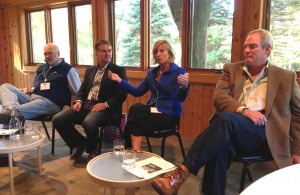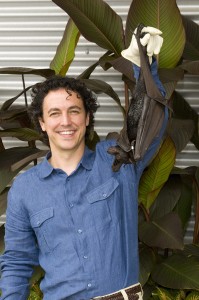
From left: Jeff Cranson, John Truscott, Deb Muchmore and Dave Waymire.
There were a number of potential defining moments from MEC’s overnight membership meeting last week:
— Peter Sinclair’s sobering presentation on disappearing Arctic ice.
— The all-star panel of communications and messaging experts (John Truscott, Deb Muchmore, Dave Waymire and Jeff Cranson) telling member groups that relationships matter – so keep your friends close and your opponents closer!
— State Rep. Wayne Schmidt, explaining how sausage is made in the legislature.
— Salmon, spawning everywhere in the Pere Marquette River flowing through the Barothy Lodge grounds. And Michigan Trout Unlimited’s Dr. Bryan Burroughs’ riverside field trip.
But for me, this was the key moment:
The all-star panel had just counseled the audience to nurture alliances with unlikely bedfellows. Environmentalists and conservationists need talk to more than just ourselves. We must broaden outreach to the business community, conservatives, faith groups and other nontraditional allies if we’re to impact on the political and policy process.
This was good advice, offered by people (Muchmore and Truscott, particularly) who represent companies, industries and groups that we often lock horns with at the state Capitol. In essence, they were advising us on how to beat their clients! Or, perhaps, work better with them, rather than always against.
When Q&A time arrived, Dr. Grenetta Thomassey of the Tip of the Mitt Watershed Council said her organization works closely with the business and conservative communities in their area – lots of partnerships, shared goals and “agreeing to disagree” on issues where they share no common ground.
“We’re doing everything you say. But when we go to Lansing and talk to our elected officials,” she said, “it’s like a different world. They shut us down. They don’t seem to care that we’re working so inclusively with so many of their friends and supporters back in the district. How can we change that?” (paraphrasing here)
“Do you bring those people with you when you visit Lansing?” asked PR guru Waymire.
Thomassey paused. Blinked. “No. But I guess we should!”
Heads nodded all around, and you could see the light bulbs go off.
Thomassey said later that she had planned to visit Lansing with Tip of the Mitt’s business allies, dropped the idea temporarily over logistical hurdles, and then forgot all about it. Until last week.
It encapsulated for me the value that MEC’s 60-plus member organizations get for being part of the state’s largest and most successful environmental coalition. We’re the proxy for small member organizations that don’t have the staff or time to keep track of shenanigans at the State Capitol. But we’re also a convener of people, a clearinghouse for timely information and a conduit for the best and most effective practices in influencing policies affecting Michigan’s natural resources. There is strength in numbers, and in diversity.
Waymire’s tip – have your allies and people who your elected officials can’t ignore at your side – was not groundbreaking. But it was important. Sometimes it takes someone from the outside looking in to see what should be obvious.
When Thomassey knocks on a legislator’s door with business owners and conservative allies at her side, her organization’s voice will resonate with new vitality and impact. When dozens, or hundreds, of small strategies like this are added up it makes a difference. And that’s what we’re all about.
###











